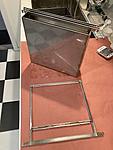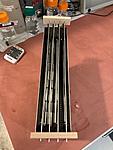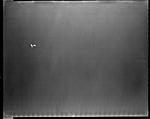I am struggling to get even development of 8x10 film in stainless tanks with vertical Kodak hangers. I've done a bunch of experiments but haven't achieved clear skies with no chemical wash marks. I'm running out of ideas and hoping folks that have figured out how to do this with manual agitation of hangers in vertical tanks could look at my process and make some suggestions.
I built the tanks a while ago, modeled after Arkay tanks. They are 2.5W" x 11L" x 10.5D". They comfortably hold 4 hangers with some space between each hanger:

I made some wood spacer clips that hold the hangers evenly apart and allow me to lift all four hangers at once:

I am developing 4 sheets of Fuji HR-U x-ray film (double sided emulsion) using 510-Pyro at 1:250 dilution for 10 minutes.
My current best development process is:
- Soak for 4 minutes in water
- 1 minute of constant agitation
- Agitation every 30s after
- Fix 4 min in TF-5 and wash 10 min
The results are very much dependent on agitation technique and I've tried a lot of variations. Based on older posts on this forum, I am currently using the following technique:
- Lift (all 4); tip to >=45 degrees away from me; lower
- Lift (all 4); tip to >=45 degrees towards me; lower
Each dip-dunk is about 5s.
Here is a pure gray field developed in this way (with contrast adjusted digitally to make the issues obvious):

There seem to be three issues:
- Surge marks from the pores in the hanger on the bottom edge
- Chemical wash marks over the surface, primarily in a vertical orientation
- Horizontal banding (which I have attributed to my scanner and we can ignore)
I have figured out how to make the surge marks at the bottom go away by lowering the hangers slowly so as not to force developer through the pores. This works out to 1s raise, 1s tip, 3s lower.

However, the chemical wash marks remain (maybe get worse). In the past, I've tried other frequencies and timings, for example:
- 30s continuous + 1 dip/dunk every minute
- Extremely slow dip/dunk motions
- Rough / fast dip/dunk motions
- More extreme tip angle
- No wood spacer holding hangers apart
All of these were worse in some way worse than where I'm at. I feel like I either need more agitation with more variety of chemical movement or less.
One other interesting data point is that 4x5 negatives developed with the same tanks and same process look great. Even skies; no surging. The only difference I can see is the 4x5 hangers have cross pieces, which must affect chemical flow.
Ideas would bet greatly appreciated.
Sam





 Reply With Quote
Reply With Quote


Bookmarks